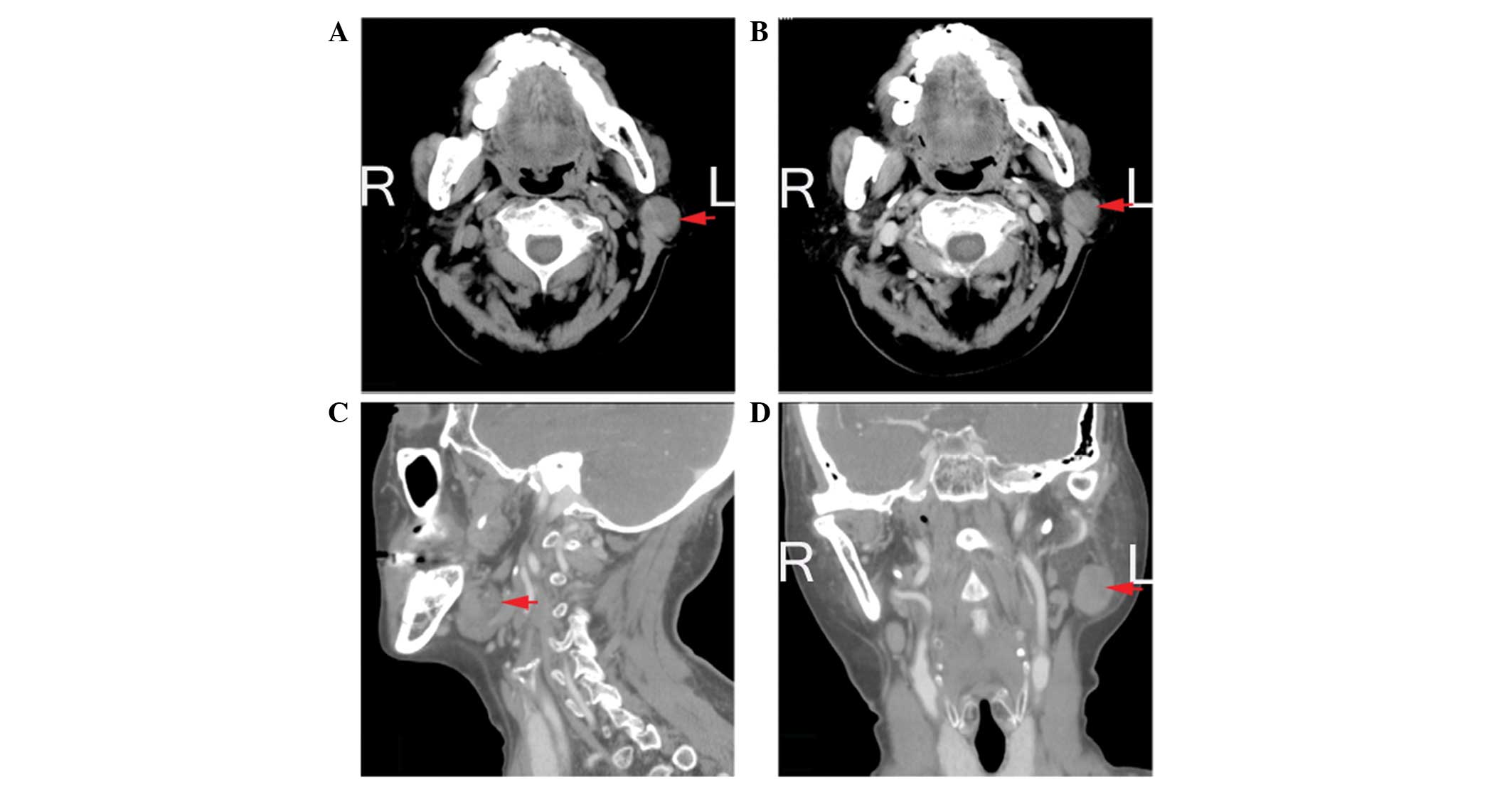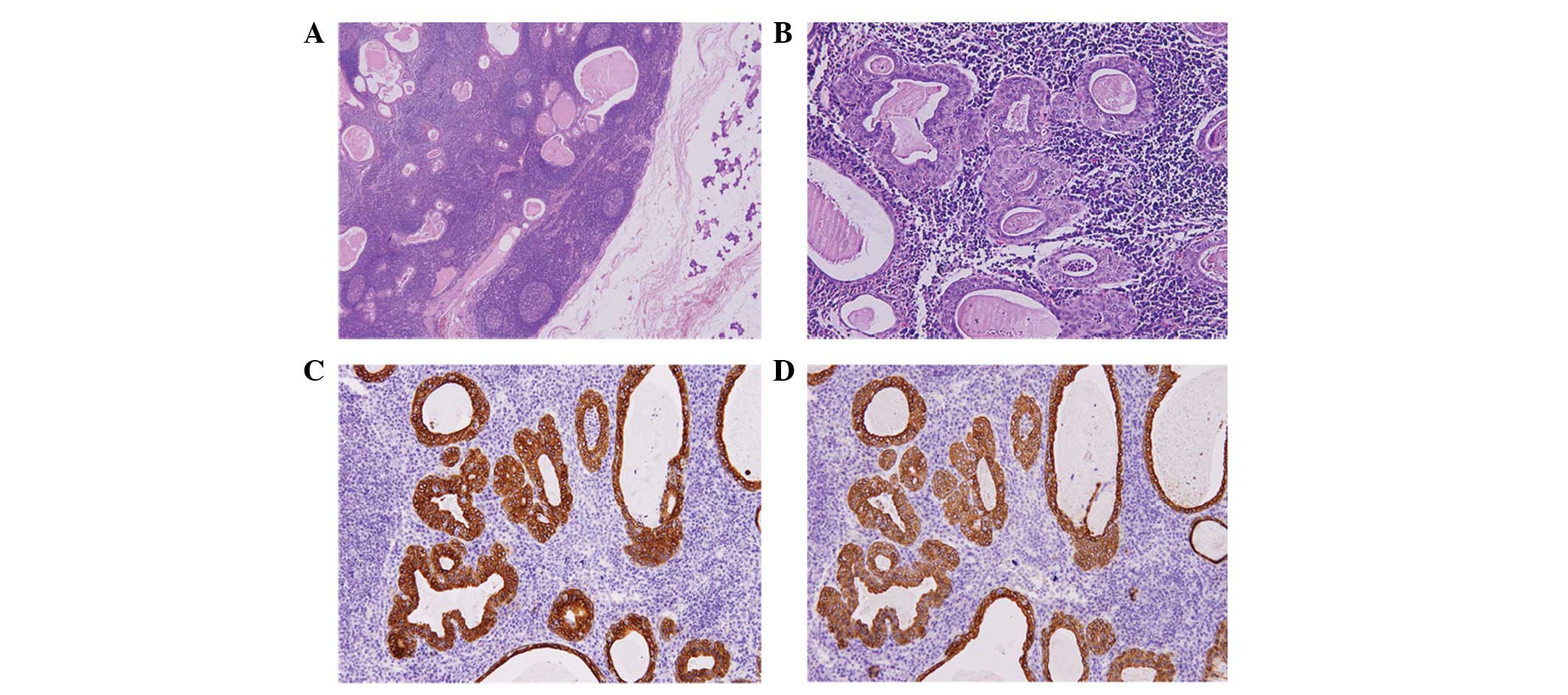Lymphadenoma of the salivary gland: Report of 10 cases
- Authors:
- Guanglong Liu
- Jie He
- Chunye Zhang
- Shuiting Fu
- Yue He
-
View Affiliations
Affiliations: Department of Oral and Maxillofacial‑Head and Neck Oncology, Ninth People's Hospital, Shanghai Jiao Tong University School of Medicine, Shanghai 200011, P.R. China, Department of Oral Pathology, Ninth People's Hospital, Shanghai Jiao Tong University School of Medicine, Shanghai 200011, P.R. China
- Published online on: January 24, 2014 https://doi.org/10.3892/ol.2014.1827
-
Pages:
1097-1101
Metrics:
Total
Views: 0 (Spandidos Publications: | PMC Statistics:
)
Metrics:
Total PDF Downloads: 0 (Spandidos Publications: | PMC Statistics:
)
This article is mentioned in:
Abstract
Lymphadenoma of the salivary gland is rare, and the typical characteristics of lymphadenoma remain poorly understood. The aim of this study was to analyze the experience of a single institution in the clinical diagnosis, treatment and prognosis of this type of tumor of the salivary gland. All cases of lymphadenoma diagnosed at the institution between 1996 and 2012 were analyzed. The clinical information (including age, gender and tumor location, process of tumor development, imaging data, surgical treatment and follow‑up information) and pathological features were evaluated. All tumors occurred in the parotid glands; three cases were sebaceous lymphadenoma (two male and one female) and seven were non‑sebaceous lymphadenoma (three male and four female). The average ages of the patients were 68.3 and 42.4 years for the sebaceous and non‑sebaceous groups, respectively. The majority of cases (90%) were diagnosed as pleomorphic adenoma or adenolymphoma prior to surgery, but were confirmed as lymphadenoma by pathological analysis following surgery. During the follow‑up period, which ranged between 3 and 36 months with a mean of 30 months, no recurrence of the lesion was identified and the quality of life was good for each patient. In conclusion, the diagnosis of salivary gland lymphadenoma should be based on the clinical and, in particular, the pathological manifestations of the disease. Immunohistochemistry is considered as a practical and helpful adjuvant method of the diagnosis for this type of tumor. Complete surgical resection is the first choice of treatment. Further exploration of the histological origin of lymphadenoma of the salivary gland is necessary due to the insufficient number of reported cases.
View References
|
1
|
McGavran MH, Bauer WC and Ackerman LV:
Sebaceous lymphadenoma of the parotid salivary gland. Cancer.
13:1185–1187. 1960. View Article : Google Scholar : PubMed/NCBI
|
|
2
|
Seethala RR, Thompson LD, Gnepp DR, et al:
Lymphadenoma of the salivary gland: clinicopathological and
immunohistochemical analysis of 33 tumors. Mod Pathol. 25:26–35.
2012. View Article : Google Scholar : PubMed/NCBI
|
|
3
|
Weiler C, Agaimy A, Zengel P, Zenk J,
Kirchner T and Ihrler S: Nonsebaceous lymphadenoma of salivary
glands: proposed development from intraparotid lymph nodes and risk
of misdiagnosis. Virchows Arch. 460:467–472. 2012. View Article : Google Scholar
|
|
4
|
Dardick I and Thomas MJ: Lymphadenoma of
parotid gland: Two additional cases and a literature review. Oral
Surg Oral Med Oral Pathol Oral Radiol Endod. 105:491–494. 2008.
View Article : Google Scholar : PubMed/NCBI
|
|
5
|
Cheuk W and Chan JK: Advances in salivary
gland pathology. Histopathology. 51:1–20. 2007. View Article : Google Scholar
|
|
6
|
Yang S, Chen X, Wang L and Zhang J:
Non-sebaceous lymphadenoma of the salivary gland: case report with
immunohistochemical investigation. Virchows Arch. 450:595–599.
2007. View Article : Google Scholar : PubMed/NCBI
|
|
7
|
Castelino-Prabhu S, Li QK and Ali SZ:
Nonsebaceous lymphadenoma of the parotid gland: cytopathologic
findings and differential diagnosis. Diagn Cytopathol. 38:137–140.
2010.
|
|
8
|
Gallego L, Junquera L and Fresno MF:
Non-sebaceous lymphadenoma of the parotid gland:
immunohistochemical study and DNA ploidy analysis. Oral Surg Oral
Med Oral Pathol Oral Radiol Endod. 107:555–558. 2009. View Article : Google Scholar : PubMed/NCBI
|
|
9
|
Chang KT, Chadha NK, Leung R, Shago M,
Phillips MJ and Thorner PS: Lymphadenoma: case report of a rare
salivary gland tumor in childhood. Pediatr Dev Pathol. 13:331–337.
2010. View Article : Google Scholar : PubMed/NCBI
|
|
10
|
Kwon GY, Kim EJ and Go JH: Lymphadenoma
arising in the parotid gland: a case report. Yonsei Med J.
43:536–538. 2002. View Article : Google Scholar : PubMed/NCBI
|
|
11
|
Bos I, Meyer S and Merz H: Lymphadenoma of
the parotid gland without sebaceous differentiation.
Immunohistochemical investigations. Pathologe. 25:73–78. 2004.(In
German).
|
|
12
|
Ma J, Chan JK, Chow CW and Orell SR:
Lymphadenoma: a report of three cases of an uncommon salivary gland
neoplasm. Histopathology. 41:342–350. 2002. View Article : Google Scholar : PubMed/NCBI
|
|
13
|
Musthyala NB, Low SE and Seneviratne RH:
Lymphadenoma of the salivary gland: a rare tumour. J Clin Pathol.
57:10072004. View Article : Google Scholar : PubMed/NCBI
|
|
14
|
Gnepp DR and Brannon R: Sebaceous
neoplasms of salivary gland origin. Report of 21 cases. Cancer.
53:2155–2170. 1984. View Article : Google Scholar : PubMed/NCBI
|
|
15
|
Auclair PL: Tumor-associated lymphoid
proliferation in the parotid gland. A potential diagnostic pitfall.
Oral Surg Oral Med Oral Pathol. 77:19–26. 1994. View Article : Google Scholar : PubMed/NCBI
|
|
16
|
Chang JY and Hsiao CH: Lymphadenoma
lacking sebaceous differentiation in the parotid gland. J Formos
Med Assoc. 103:459–462. 2004.PubMed/NCBI
|
|
17
|
Rawlinson NJ, Almarzooqi S and Nicol K:
Sebaceous lymphadenoma of the parotid gland in a 13-year-old girl:
a case report. Head Neck Pathol. 4:144–147. 2010.PubMed/NCBI
|
|
18
|
Sun G, Hu Q, Huang X and Tang E: Sebaceous
lymphadenoma of parotid gland in a child. Oral Surg Oral Med Oral
Pathol Oral Radiol Endod. 107:253–255. 2009. View Article : Google Scholar : PubMed/NCBI
|
|
19
|
Batsakis JG and el-Naggar AK: Sebaceous
lesions of salivary glands and oral cavity. Ann Otol Rhinol
Laryngol. 99:416–418. 1990. View Article : Google Scholar : PubMed/NCBI
|











